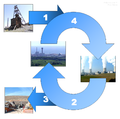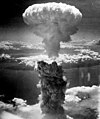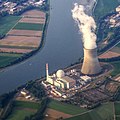Portal:Nuclear technology
The Nuclear Technology Portal
Introduction

- Nuclear technology is technology that involves the nuclear reactions of atomic nuclei. Among the notable nuclear technologies are nuclear reactors, nuclear medicine and nuclear weapons. It is also used, among other things, in smoke detectors and gun sights. (Full article...)
- Nuclear power is the use of nuclear reactions to produce electricity. Nuclear power can be obtained from nuclear fission, nuclear decay and nuclear fusion reactions. Presently, the vast majority of electricity from nuclear power is produced by nuclear fission of uranium and plutonium in nuclear power plants. Nuclear decay processes are used in niche applications such as radioisotope thermoelectric generators in some space probes such as Voyager 2. Reactors producing controlled fusion power have been operated since 1958 but have yet to generate net power and are not expected to be commercially available in the near future. (Full article...)
- A nuclear weapon is an explosive device that derives its destructive force from nuclear reactions, either fission (fission bomb) or a combination of fission and fusion reactions (thermonuclear bomb), producing a nuclear explosion. Both bomb types release large quantities of energy from relatively small amounts of matter. (Full article...)
General images -
Selected article -
The United Kingdom signed the Comprehensive Nuclear Test Ban Treaty in 1996 and ratified it in 1998, confirming the British commitment towards ending nuclear test explosions in the world. (Full article...)
Selected picture -
Did you know?
- ... that the medieval Castle Knob was the site of a Cold War nuclear monitoring station?
- ... that campaigning by climate activist Kimiko Hirata halted plans to build 17 new coal-fired power plants following the Fukushima nuclear disaster in Japan?
- ... that the Russian and Belarussian military exercise Zapad 2009 involved nuclear-capable ballistic missiles?
- ... that an official investigation found the Fukushima nuclear accident was foreseeable and preventable?
- ... that after journalist Adele Ferguson's criticism of the U.S. Navy's sex discrimination attracted nationwide attention, she was offered a personal tour of a nuclear submarine?
- ... that a nuclear reactor was nearly built at the New York Hall of Science, but the money for the institution instead went to Yankee Stadium?
Related WikiProjects
Things you can do
| Parts of this portal (those related to section) need to be updated. Please help update this portal to reflect recent events or newly available information. Relevant discussion may be found on the talk page. (September 2021) |
Selected biography -
Born in Boyarka in the old Russian Empire, into "an old Ukrainian Cossack family which was part of the intellectual elite in pre-revolutionary Russia", Kistiakowsky fled his homeland during the Russian Civil War. He made his way to Germany, where he earned his PhD in physical chemistry under the supervision of Max Bodenstein at the University of Berlin. He emigrated to the United States in 1926, where he joined the faculty of Harvard University in 1930, and became a citizen in 1933.
During World War II, Kistiakowsky was the head of the National Defense Research Committee (NDRC) section responsible for the development of explosives, and the technical director of the Explosives Research Laboratory (ERL), where he oversaw the development of new explosives, including RDX and HMX. He was involved in research into the hydrodynamic theory of explosions, and the development of shaped charges. In October 1943, he was brought into the Manhattan Project as a consultant. He was soon placed in charge of X Division, which was responsible for the development of the explosive lenses necessary for an implosion-type nuclear weapon. In July 1945, he watched the first atomic explosion in the Trinity test. A few weeks later, another implosion-type weapon (Fat Man) was dropped on Nagasaki.
From 1962 to 1965, Kistiakowsky chaired the National Academy of Sciences's Committee on Science, Engineering, and Public Policy (COSEPUP), and was its vice president from 1965 to 1973. He severed his connections with the government in protest against the war in Vietnam, and became active in an antiwar organization, the Council for a Livable World, becoming its chairman in 1977. (Full article...)
Nuclear technology news
- 14 December 2024 – 2024 New Jersey drone sightings
- The Public Service Enterprise Group files a request with the Federal Aviation Administration to close the airspace over two of its nuclear power plants to all aircraft after unidentified drones were spotted hovering over the facilities in New Jersey. (The New York Post via MSN)
- 10 December 2024 – Belarus–Russia relations, Nuclear risk during the Russian invasion of Ukraine
- Belarusian President Alexander Lukashenko confirms the presence of nuclear weapons in his country, including Russia's Oreshnik missile system. (AP)
- 6 December 2024 – Belarus–Russia relations, Nuclear risk during the Russian invasion of Ukraine
- Russian President Vladimir Putin and Belarusian President Alexander Lukashenko sign an agreement in Minsk, Belarus, offering security guarantees to Belarus including nuclear security and the possible use of Russian nuclear weapons in order to repel aggressions. (AP)
Related portals
Related topics
Subcategories
Associated Wikimedia
The following Wikimedia Foundation sister projects provide more on this subject:
-
Commons
Free media repository -
Wikibooks
Free textbooks and manuals -
Wikidata
Free knowledge base -
Wikinews
Free-content news -
Wikiquote
Collection of quotations -
Wikisource
Free-content library -
Wikiversity
Free learning tools -
Wiktionary
Dictionary and thesaurus






































































































